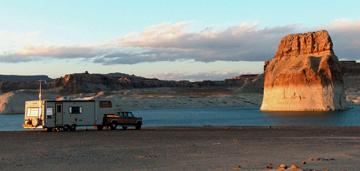

Fulltiming refers to a subset of RVers who live and travel full time in their RV. Normally, these Rvers do not have a traditional house (sometimes called a "stick" house).
Purists may define fulltiming in a strict sense - to mean no house, condo, RV lot or any other physical roost to return to. Others allow that if someone is living and traveling in their RV most of the year, they are fulltimers. Like most RVers, we don't get too fussy about the definitions. If someone thinks of themselves as fulltimers, that's okay with us.
In our case, our only home is the RV. Like a turtle, our home goes with us. All of our possessions are stored on board - in inerior cabinets, exterior bays or our tow car.
Fulltimers share the interests of the overall community of RVers. Talk of rallies and boondocking and toads. Chat rooms about plumbing and electrical matters that would never cross the mind of a non-RVer.
Yet the fulltiming RVer also deals with aspects unique to their particular type of RV lifestyle. We think it is a great way to live, but it is not for everyone and is not a decision to be taken lightly. Here are a few considerations:
Getting rid of a house and personal belongings can be emotional, to say nothing of the logistics. What to keep, what to give away, what to do with the rest.
Close family ties. People accustomed to frequent visits with family and friends need to consider how they will adjust, and how they will stay connected from across the miles. Some people find it difficult to leave a physical community or geopgraphy. On the other hand, we have met RVers who delight in their RV lifestyle as the perfect way to visit with friends and family geographically scattered around the country.
How to stay connected in general is a consideration. Mail, email, RV internet access, phones. Fulltiming RVers deal with these in different ways, and take advantage of new technology.
Space: Less of it for things. We can often find yet another niche to stash yet another thing into our motorhome. But make no bones about it - it's a big change from the land of walk-in closets, basement shelves and "room in the garage".
Space - less of it for you. Less personal space and privacy. People living together fulltime in an RV need to be able to get along. They will be together more often and in much closer quarters than traditional living.
Costs. Fulltiming RVers need to plan what it will cost them to live a fulltime lifestyle. This means budgeting for day-to-day living expenses on the road, as well as planning for the future.
The traditional house is an appreciating asset. The typical RV depreciates over time. Money may be needed to replace or upgrade an RV. Or the fulltimer may want to plan for a time when they travel less frequently and also maintain a more traditional home.
Jobs. The fulltimer may want to consider working on the road to supplement income. There are lots of options available. As you ponder the choices, think about what impact working will have on your planned fulltiming lifestyle.
Some jobs require a commitment of time in one location. Others can be taken on the road. What types of RVer jobs merit consideration?
Establishing an RV home base. Fulltimers still need a home base for a variety of reasons including voting, medical coverage, insurance, taxes, drivers' licenses, etc.
And so on.
When we first became intrigued by the thought of fulltiming, we started reading. We read books that dealt with RV living, and fulltimer experiences. We read books that not only educated us - they inspired us!
We got different perspectives and ideas.
We think this kind of research is a MUST for anyone pondering RV living on a fulltime (or even most-of-the-time) basis. Whether you choose to be a fulltimer or not, the learning is sure to help you create and refine your RV lifestyle.

 All it takes is for the earth to have an atmosphere and the sun to eject ions at speeds up to 1200 km/second then BAM! You’ve got some unbelievable mother nature action. Imagine what people must have thought, thousands of years ago, when they saw these streams and swirls of light and color in the evening sky. Watching this spectacular celestial phenomena today, for that matter, is beyond spectacular.
All it takes is for the earth to have an atmosphere and the sun to eject ions at speeds up to 1200 km/second then BAM! You’ve got some unbelievable mother nature action. Imagine what people must have thought, thousands of years ago, when they saw these streams and swirls of light and color in the evening sky. Watching this spectacular celestial phenomena today, for that matter, is beyond spectacular.





















